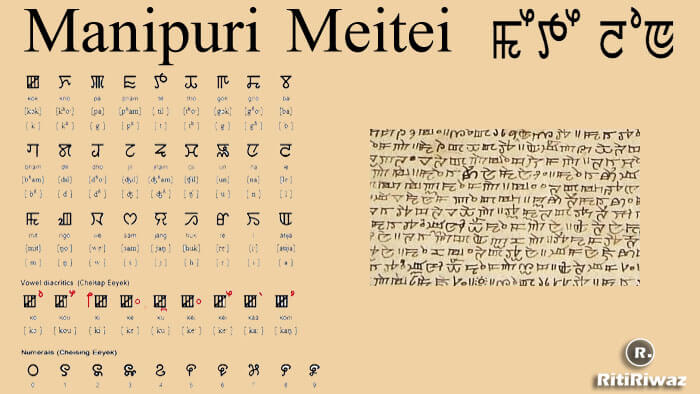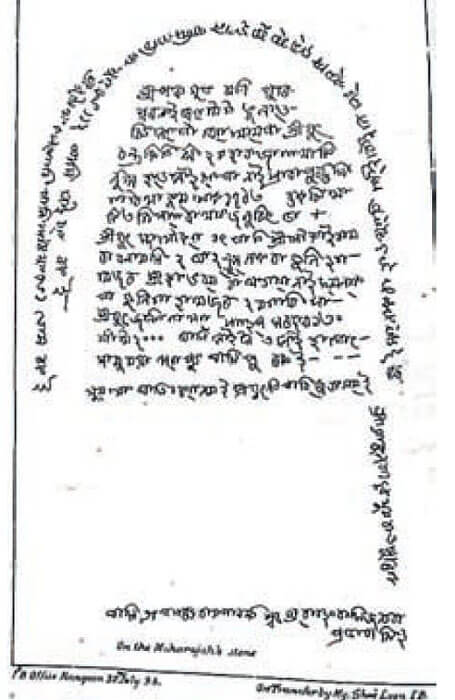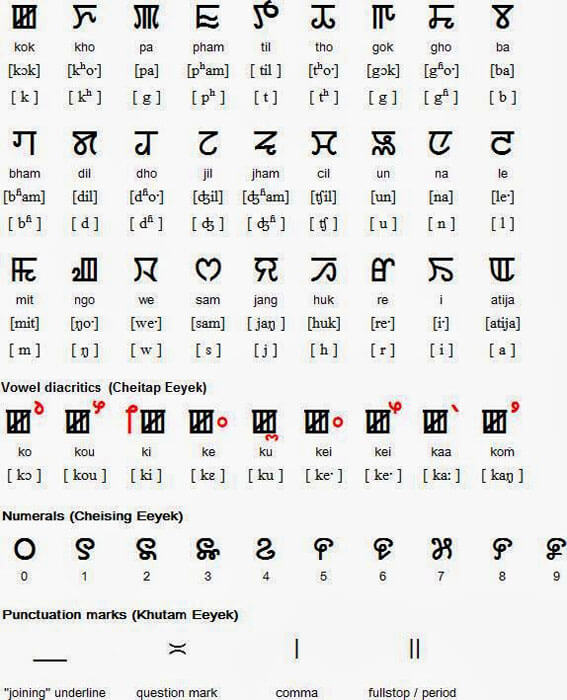Manipuri Language | Meithei

Manipuri language, Meithei, or Meetei, Meitheilon, Meeteilon, Meeʁteilon is a Sino-Tibetan language is the predominant language and lingua-franca in the state of Manipur, in northeastern India. It is the official language in government offices. Meithei has proven to be a large integrating factor among all ethnic groups in Manipur who use it to communicate among themselves.
Meithei has been recognized as the Manipuri language by the Indian Union and has been included in the list of scheduled languages (included in the 8th schedule by the 71st amendment of the constitution in 1992). Meithei is taught as a subject up to the Post-graduate level (Ph.D.) in Universities of India, apart from being a medium of instruction up to the undergraduate level in Manipur.
There are more than 39 other languages one is Bishnupriya (or Bishnupriya Manipuri), which was also spoken in the polyglot land of Manipur before the 15th century, which is mentioned in Sir G.A.Griersons “Linguistic Survey of India.” The language contains many pre-Meithei vocabularies.
The Meithei had its own script named Meetei-Mayek, which was in use until the 18th century. Subsequently, the Bengali script was adopted to write the language and is being used to date. However, efforts are being made to revive the Meetei-Mayek script.
History of Manipuri Language

Manipuri language belongs to the Kuki-Chin group of the Tibeto-Burman language family. The formation of the Tibeto-Burman tribe’s dialects was composed of the dialects of the tribes of Tibetan and Himalayan origin; Asiatic origin like Karen, Kachin, King, Kang, Kou Man, Mon, etc.; Chinese like chin, Ch‟u, etc; and Tai origin like Shen Lao, Ngai Lao, Lai, etc. besides other elements of Huns and Taratas which came comparatively later.
When these tribes got mixed a series of dialects known as Tibeto-Burman of the so-called Sino-Tibetan family of language gave birth. The Tibeto-Burman language began to develop from about the early Christian era and became fully characterized by about the 7th century A.D. The status of the Manipuri language can be divided into Pre- Vaishnavite period (1467-1709 A.D), and the Early Vaishnavite period (1467-1709 A.D) Vaishnavite period (1709- 1891A.D), and the British period (1891-1947 A.D).
Legends, songs, and manuscripts found in this language evidently prove its long and continued existence of it. It appears that though the Manipuri language is the lingua franca of the different groups, each spoke a separate dialect, and as a result of the proximity with one another or of the subsequent amalgamation, many words from those dialects have been taken over and introduced into the main language.
Manipur Language movement (1924-1992)
In independent India, the language issue emerged as one of the most acute problems. In the wake of the reorganization of states on a linguistic basis in 1956, a number of unilingual states were carved out in India.
The distribution of state boundaries was to bring people together who speak a common language. However, the linguistic formation of states can be identified as a major gain of the democratic movement as far as the national problem in India is concerned. Even this has been affected unitedly as can be seen from problems that remain even now. Thus, it is found that the national problem remains unsolved leading to the emergence of various problems like communalism, separatism, and linguistic chauvinism both at the state and regional levels.
Of various language, movements that broke out in India, the Manipuri language movement is one among them. It is the Anti classical, Anti-colonial, and State policy centric language movement. There were two kinds of Manipuri language movements that broke out in the states of Manipur and Assam in India during the 20th century.
One kind was the language movement for the introduction of the Manipuri language as a vernacular in Manipur and Medium of Instruction in Manipur and Assam and the other was the language movement for the inclusion of the Manipuri language in the Eighth Schedule of the Constitution of India.
Manipuri language movement is a kind of movement which started in Manipur and then spread to the state of Assam and other NER states, where the Manipuri populace is seen vividly. It was mainly related to the social, educational, cultural, and political development of the Manipuri people. Their aspiration on the issues of Manipuri language to be used in the education system and also to be included in the Eighth scheduled languages of India in particular.
Consequently, Manipuri as a language has been introduced as a vernacular language in Manipur and as a medium of instruction in the education system in Manipur and Assam. It has also been included in the Eighth scheduled language of India and become one of 22 scheduled languages of India.
Manipuri Dialects
The Manipuris, from a linguistic point of view, are divided into two groups, namely – the Meiteis and the Bishnupriya. The Meiteis entered Manipur from the east; their Language is of the Tibeto-Burman group. The Bishnupriya entered Manipur from the west; their language is of the Indo-Aryan group.
The three main dialects of Meitei are Meitei proper, Loi, and Pangal. Differences between these dialects are primarily characterized by the extensions of new sounds and tonal shifts. Meitei proper is considered, of the three, to be the standard variety and is viewed as more dynamic than the other two dialects.
Manipuri Writing

Meitei has its own script, which was used until the 18th century. Its earliest use is not known. Pamheiba, the ruler of the Manipur Kingdom who introduced Hinduism, banned the use of the Meitei script and adopted the Bengali script. Now in schools and colleges, the Bengali script is gradually being replaced by the Meitei script. The local organizations have played a major role in spreading awareness about their own script. The local organizations have played a major role in spreading awareness about their own script.
Between 1709 and the middle of the 20th century, the Meitei language was written using the Bengali script. During the 1940s and 1950s, Meitei scholars began campaigning to bring back the Old Meitei (Old Manipuri) alphabet. In 1976 at a writer’s conference, all the scholars finally agreed on a new version of the alphabet containing a number of additional letters to represent sounds not present in Meitei when the script was first developed. The current Meitei alphabet is a reconstruction of the ancient Meitei script.
Greetings in Manipuri Language
Hello – Khurumjari
Thank you – Yamna nungaijare/ Thagatchari
Thank you very much – Hainingai Leitana Thagatchari
Good Bye – Chatcharage
How are you? – Noong_ngai_biribra adombo?
Fine – Noongaijari
Welcome – Lengsinbirak_oo
I love Manipur – Ei Manipur nungshi
Suggested Read: Manipur – Culture and Tradition






